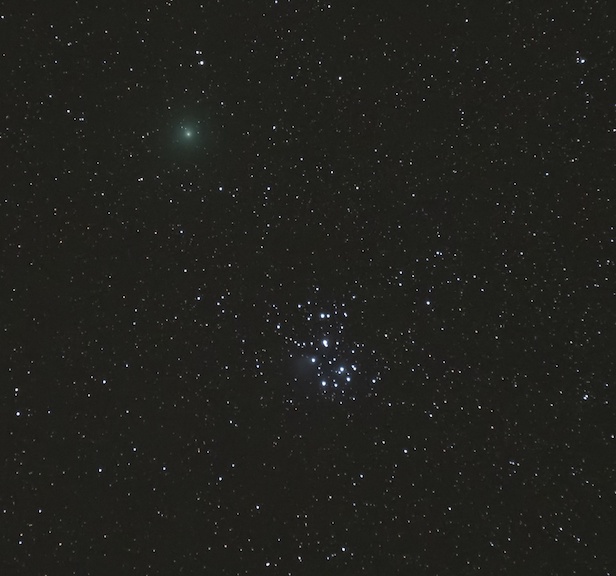Keck Observatory views Comet Wirtanen in unprecedented detail
The NIRSPEC upgrade at the Keck Observatory has delivered sharper views of Comet Wirtanen

Comet 46P/Wirtanen, pictured in the upper-left near the Pleiades, a star cluster in the constellation Taurus, is nicknamed the ‘Christmas Comet’ due to its fuzzy, bright green glow and the timing of its holiday flyby. Image credit: Barbara Schaefer
Astronomers are being treated to an exciting view of Comet 46P/Wirtanen at W. M. Keck Observatory, Hawai’i, with sharper-than-ever data images of this icy and rocky space visitor.
A group of comet scientists led by Boncho Bonev, Physics Research Assistant Professor at American University, just completed their two-night observation of the comet as it made its long-anticipated closest approach to Earth.
“It is very exciting because the comet is so close and sufficiently bright for detailed astronomical studies,” says Bonev. “Comet Wirtanen is only 30 lunar distances from our planet, meaning that it is about 30 times the distance to the Moon. That is nothing compared to the vast distances astronomers typically work with.”
NASA awarded Bonev’s team telescope time on 16-17 December 2018, at Keck Observatory to study Comet Wirtanen. The researchers used the Observatory’s Near-Infrared Spectrograph (NIRSPEC) for the first time on a comet since this powerful instrument’s recent major upgrade.
“In the two decades since we delivered NIRSPEC to Keck Observatory in 1999, the technology for digital infrared cameras has greatly improved,” says UCLA Physics and Astronomy Distinguished Professor Ian McLean, the original principal investigator who was instrumental in commissioning NIRSPEC at Keck Observatory in 1999. “So we installed more sensitive detectors, replacing the digital imaging devices, along with other mechanisms and optics, with brand new ones to give the instrument a new lease of life.”
“It’s very sensitive. The new detector will allow us to see about an order of magnitude fainter objects in the sky,” says NIRSPEC Instrument Master Greg Doppmann, an astronomer at Keck Observatory. “It has the new Hawaii 2RG Teledyne chip so it has more pixels – the pixels are smaller and they’re much more sensitive – which means much more improvement in the results we get when we operate NIRSPEC on the telescope.”

Comet Wirtanen’s historic flyby happened to coincide with the annual Geminid meteor shower, giving stargazers an extra spectacular show in the night sky. CREDIT: Josh Walawender/W. M. Keck Observatory Astronomer
“We’re excited about the NIRSPEC upgrade,” says Keck Observatory Chief Scientist John O’Meara. “It’s going to produce amazing gains in efficiency. You can look at many more objects or get better data for the same amount of time on the sky. It’s like doubling the gas mileage on your car.”
The improvements were specifically completed in time for the comet’s historic flyby. Within just the first scan, the researchers successfully captured spectra of Comet Wirtanen, marking first science for the new NIRSPEC.
“This comet passage is particularly important because of its proximity to the Earth as it passes,” says UCLA Physics and Astronomy Associate Professor Michael Fitzgerald, the principal investigator of the NIRSPEC upgrade. “Comets are relics of the Solar System; this should allow us to get a detailed understanding of the chemical makeup of this building block of the Solar System, and ultimately paint a picture of how planetary systems came to be.”
“I’m really excited that NIRSPEC is already being used for such a critical science mission designed to meet one of NASA’s science goals,” says NIRSPEC Instrument Scientist and Keck Visiting Scholar Emily Martin, now a National Science Foundation postdoctoral fellow at the University of California, Santa Cruz, United States. “It’s possible that we’ll see exotic molecular species that have never been observed on a comet before, and this is only possible because we upgraded NIRSPEC.”
Bonev’s team is specifically looking for what are called prebiotic molecules, such as water, ammonia, hydrocarbons, and other organic compounds that are precursor ingredients to forming life.
“We’re so thankful to the NIRSPEC team for their hard work in making the upgrades a reality for us. This allows us to search for these key molecules, which ultimately helps us find answers to our origins,” says Bonev. “Though our goal is to characterise Comet Wirtanen’s chemical composition, there is always the possibility to see something unexpected or discover something new that will raise new questions to address. That’s what makes science so exciting!”

Keep up to date with the latest news in All About Space – available every month for just £4.99. Alternatively you can make the most of our Christmas offer and subscribe here for a fraction of the price!




